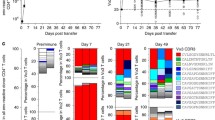Abstract
Antigen-specific antibody responses were investigated in 32 hypogammaglobulinemic patients with common variable immunodeficiency followingin vitro sensitization of their peripheral blood lymphocyte cultures with sheep red blood-cell determinants. Anti-sheep red blood-cell antibody-secreting cells were quantitated in a hemolytic plaque assay. Amplification of T-cell help was achieved with the use of the T-cell mitogen concanavalin A or allogeneic irradiated T cells. Four patients groups, A through D, were identified. Group A was comprised of 10 patients whose cultured lymphocyte readily developed into antibody secreting cells. Cultures of 9 patients (Group B) responded suboptimally, but were enhanced following mitogen activation of autologous or exogenous T cells, and those of 7 patients (Group C) responded only when help was aplified. In 7 patients (Group D), no responses were elicited. On the simultaneous assessment of pokeweed mitogen-driven polyclonal generation of immunoglobulin-secreting cells, only 10 responders, all from groups A and B, were identified. Our observations indicate that the majority of patients with common variable immunodeficiency possesses B cells capable of producing antibodyin vitro. The ability of some patients' B cells to respond only in the antigen-specific assay while failing to do so in pokeweed mitogen-stimulated cultures suggests that these two reactions are not identical in their activation pathways.
Similar content being viewed by others
References
Cunningham-Rundles S, Cunningham-Rundles C, Siegal FP, Gupta S, Smithwick EM, Kosloff C, Good RA: Defective cellular immune responsein vitro in common variable immunodeficiency. J Clin Immunol 1:65–72, 1981
WHO: WHO report: Immunodeficiency. Clin Immunol Immunopathol 13:296–359, 1979
Siegal FP, Pahwa S, Pahwa R: Congenital and acquired primary disorders of B and T lymphocyte function.In Infections in the Abnormal Host, MH Grieco (ed). New York, Yorke Medical, 1980, pp 129–162
Wu L, Lawton AR, Cooper MD: Differentiation capacity of cultured B lymphocytes from immunodeficient patients. J Clin Invest 52:3180–3189, 1973
Geha RS, Schneeberger E, Merler E, Rosen FS: heterogeneity of “acquired” or common variable agamma globulinemia. N Engl J Med 291:1–6, 1974
Waldmann TA, Durm M, Broder S, Blackman M, Blaese RM, Strober W: Role of suppressor T cells in pathogenesis of common variable hypogammaglobulinemia. Lancet 2:609–613, 1974
de la Concha EG, Oldham G, Webster ADB, Asherson GL, Platts-Mills TAE: Quantitative measurements of T- and B-cell function in “variable” primary hypogammaglobulinemia: Evidence for a consistent B-cell defect. Clin Exp Immunol 27:208–215, 1977
Ciccimarra F, Rosen FS, Schneeberger E, Merler E: Failure with heavy chain glycosylation of IgG in some patients with common variable agammaglobulinemia. J Clin Invest 57:1386–1390, 1976
Schwartz S, Choi YS, Shou L, Good RA: Modulatory effects on immunoglobulin synthesis and secretion by lymphocytes from immunodeficient patients. J Clin Invest 59:1176–1187, 1977
Siegal FP, Siegal M, Good RA: Role of helper, suppressor, and B cell defects in the pathogenesis of the hypogammaglobulinemias. N Engl J Med 299:172–178, 1978
Reinherz EL, Rubinstein A, Geha RS, Strelkauskas AJ, Rosen FS, Schlossman SF: Abnormalities of immunoregulatory T cells in disorders of immune function. N Engl J Med 301:1018–1021, 1979
Galanaud P:In vitro antibody responses to trinitrophenyl-polyacrylamide beads. Immunol Rev 45:141–161, 1979
Stevens RH, Tamaroff M, Saxon A: Inability of patients with common variable hypogammaglobulinemia to generate lymphoblastoid B cells following booster immunization. Clin Immunol Immunopathol 16:336–343, 1980
Gelfand EW, Dosch HM:In vitro functional heterogeneity of humoral and cellular immune deficiency states.In Antibody Production in Man, AS Fauci, Ballieux (eds). New York, Academic Press, 1979, pp 309–324
Yarchoan R, Strober W, Schneider H, Nelson DL: Assessment of specific anti-influenza virus antibody productionin vitro in patients with hypogammaglobulinemia. Clin Res 29:380A, 1981
Misiti J, Waldman TA:In vitro generation of antigen specific hemolytic plaque forming cells (PFC) in man. Fed Proc 40:1033, 1981
Hoffmann MK: Antigen specific induction and regulation of antibody synthesis in cultures of human peripheral blood mononuclear cells. Proc Natl Acad Sci USA 77:1139–1143, 1980
Pahwa S, Pahwa R, Good RA: Decreasedin vitro humoral immune responses in aging human subjects. J Clin Invest 67:1094–1102, 1981
Mishell FI, Dutton RW: Immunization of dissociated spleen cell cultures from normal mice. J Exp Med 126:423–442, 1967
Muchmore AV, Koski I, Dooley N, Blaese RM: Artifactual plaque formationin vitro andin vivo due to passive transfer of specific antibody. J Immunol 116:1016–1023, 1976
Pahwa S, Good RA, Hoffmann M: Role of mitogens and antigens in antibody production by human B lymphocytes. J Clin Immunol 1:101–105, 1981
Kessler SW: Rapid isolation of antigens from cells with a staphylococcal protein-A antibody adsorbent. Parameters of the interaction of antibody-antigen complexes with protein A. J Immunol 115:1617–1624, 1975
Finelt M, Hoffmann MK: A human monocyte function test: Release of B cell differentiation factor. Clin Immunol Immunopathol 12:281–288, 1979
Pahwa S, Shou L, Pahwa R, Smithwick E, Good RA: Influence of human thymocytes on B-lymphocyte differentiation in man. Cell Immunol 44:433–441, 1979
Jerne NK, Nordin AA: Plaque formation in agar by single antibody producing cells. Science 140:405–407, 1963
Gronowicz E, Coutinho A, Melchers F: A plaque assay for all cells secreting Ig of a given type or class. Eur J Immunol 6:588–590, 1976
Waxdal MJ, Nillson SF, Basham TY: Heterogeneity of the pokeweed mitogen and the responding lymphocytes.In Mitogens in Immunology, JJ Openheim, DL Rosenstreich (eds). New York, Academic Press, 1976, pp 161–172
Fauci AS: Human B cell function in a polyclonally induced plaque forming cell system. Cell triggering and immunoregulation. Immunol Rev 45:93–116, 1979
Rosenberg SA, Lipsky PE: Monocyte dependence of pokeweed mitogen-induced differentiation of immunoglobulinsecreting cells from human peripheral blood mononuclear cells. J Immunol 122:926–931, 1979
Montazeri G, Chiorrazi N, Fu SM, Kunkel HG: Regulatory role of circulating monocytes in the differentiative and proliferative responses of human B lymphocytes. J Exp Med 16:1–10, 1980
Hoffmann MK: Control of B cell differentiation by macrophages. Ann NY Acad Sci 332:557–563, 1979
Author information
Authors and Affiliations
Rights and permissions
About this article
Cite this article
Pahwa, S.G., Hoffman, M.K., Pahwa, R.N. et al. Polyclonal and antigen-specific B-Cell responses in patients with common variable immunodeficiency. J Clin Immunol 2, 205–213 (1982). https://doi.org/10.1007/BF00915223
Accepted:
Issue Date:
DOI: https://doi.org/10.1007/BF00915223



